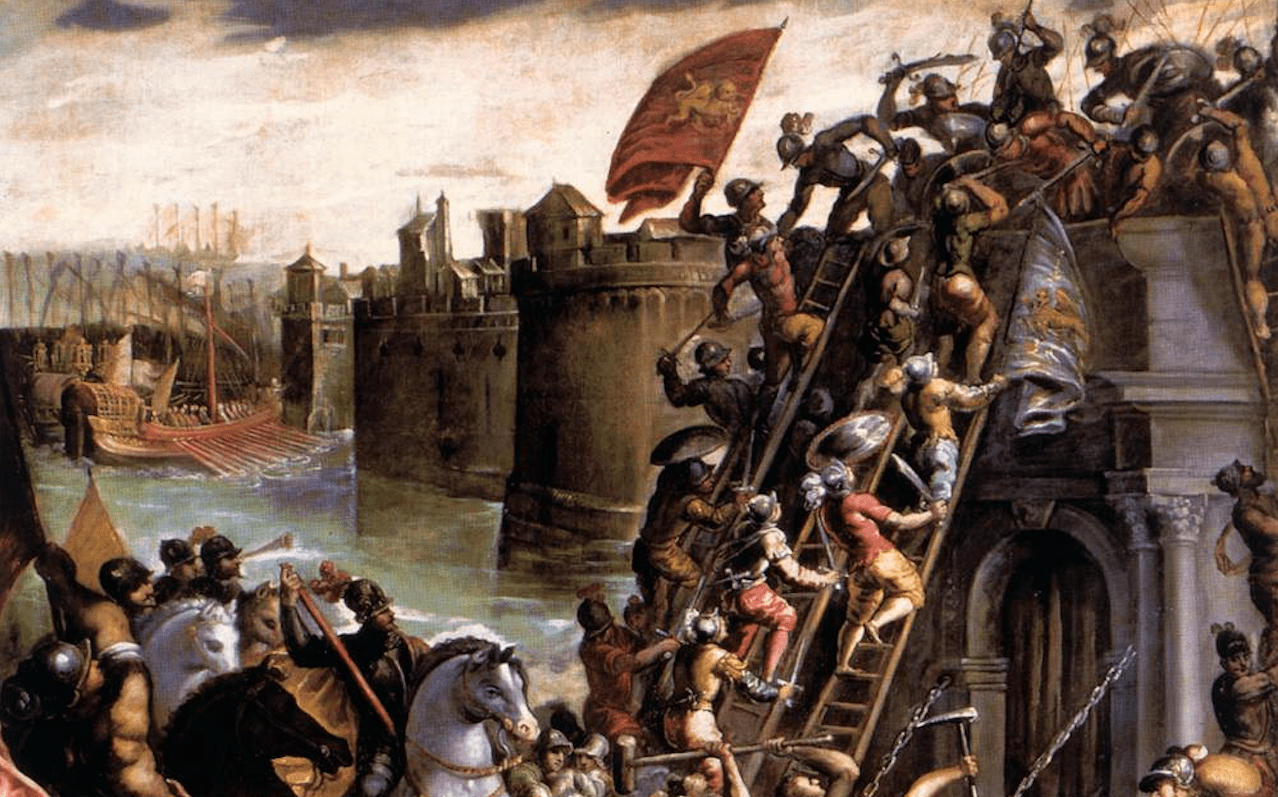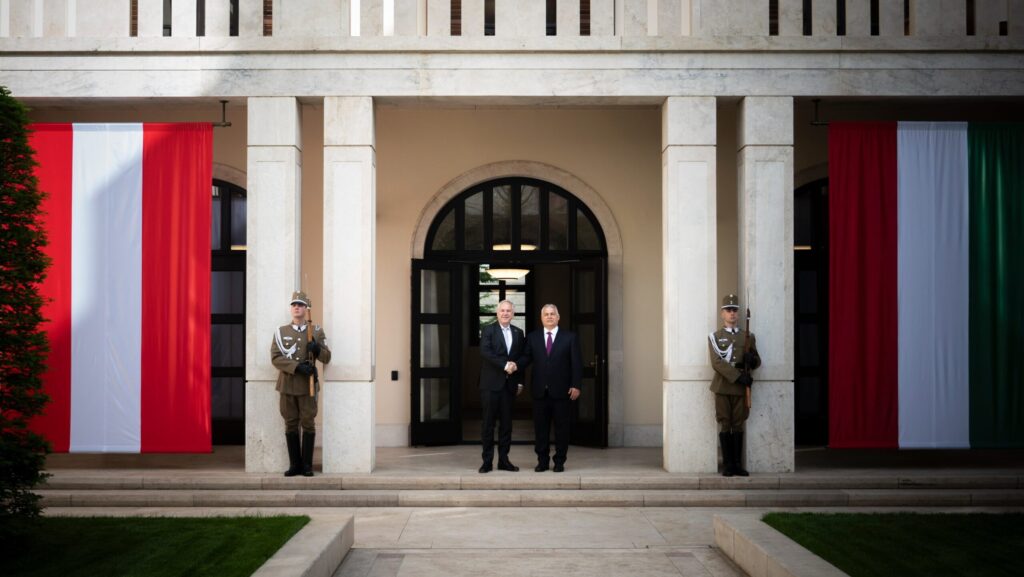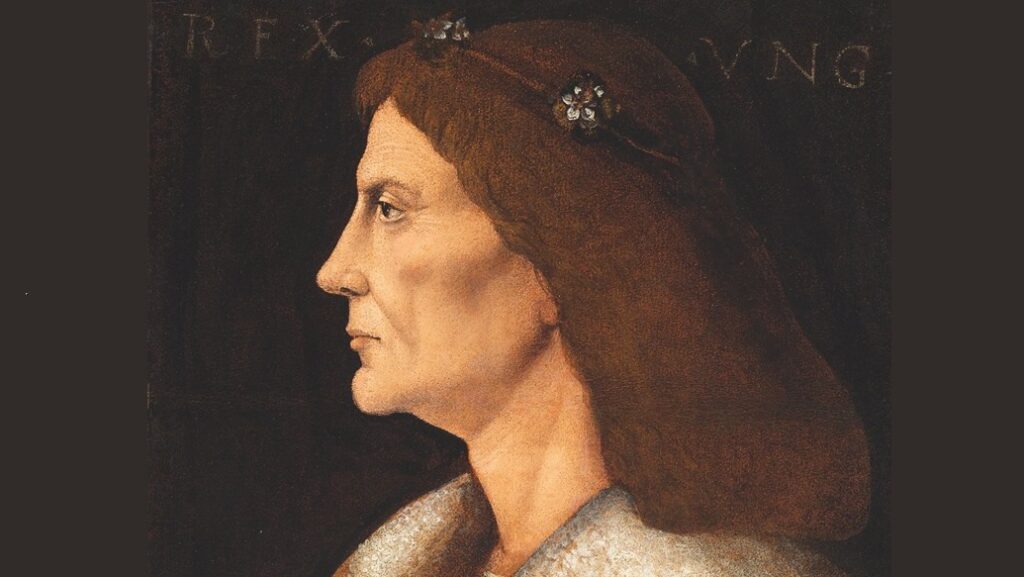There is nothing surprising about crusades having crossed the territory of the Kingdom of Hungary as well, since the most important land route to the Holy Land led through the country, via Belgrade, Sofia, and Byzantium. However, in 1202, the crusaders arrived by sea at the Dalmatian trading town Zadar (Zadar is the Croatian name, while the Italian name of the town is Zara or Zára in Hungarian), located on the coast of the Adriatic Sea, under Hungarian rule at the time.[1]
In early October 1202, the crusaders set off from the Venice Lido, but at the time perhaps no one thought that the campaign would end in Constantinople, not Egypt. However, they had to know already at the time of the departure that they had missed the autumn shipping season, because according to the Venetian regulations, their ships had to arrive in present-day Akko (Akkon) in northern Israel by 8 October at the latest. They could have wintered near the European coast in a port under Venetian rule, such as Corfu, but it seemed even more favourable for them if the fleet’s winter stay of several months was attempted in Zadar, a town challenging Venice’s trading hegemony. The crusaders arrived at the port of Zadar on 10 November, St Martin’s Vigil, but the town’s leaders refused to let them in. During the first truce talks, the people of Zadar almost surrendered, but in the end, they decided to resist. However, little is known about the siege itself. The attackers easily broke through the barrier chain protecting the port, landed the siege engines, and began to undermine the walls. At first, the attackers considered the town to be impregnable: ‘How could such a town be taken by force, save with the help of God himself?’[2] However, in the end the defenders capitulated on 24 November.
The crusaders destroyed the walls and the towers, and, with the exception of the churches, all the buildings,
although that only happened later, after they left the city, since they were using them as living quarters during the winter.
Zadar was a Western Christian town with a rich history, and at that time it was once again under the authority of Emeric (Imre in Hungarian), King of Hungary (1196–1204), who himself had taken the crusader’s vow. From time to time, the crusaders would interrupt their campaign, for instance during the Second and Fifth Crusades, to engage in skirmishes with the Muslims. They intervened most prominently in the Reconquista of the Spanish peninsula in the territory of today’s Portugal, gaining great recognition by capturing Lisbon in 1147 and Alcácer do Sal (Al Qaşr) in 1217. However, the Zadar adventure was different—a scandal was in the air, and it did unfold very quickly. If crusaders take the coastal town of Zadar by siege, they bring shame on the crusading ideal by occupying a Latin Christian town instead of the Holy Land—or do they not? Historians are still engaged in a balancing act between the parties, sometimes minimizing and sometimes exaggerating the responsibility of Venice, the crusaders and the Pope respectively. But the situation was so complicated that the question cannot be answered with a simple yes or no.
Zadar, like the whole of the Dalmatian coast, was in the buffer zone of two great powers:
Byzantium, which traditionally exercised power over the region but was already in decline, and the emerging Venice. Then the Kingdom of Hungary entered the picture from the mainland at the turn of the 11th and 12th centuries. Although Hungarian kings included Dalmatia in their royal title, in reality, Dalmatia was a group of rich, rival city-states with Italian culture, but of mixed ethnicity that only forged temporary alliances with each other out of fear of Venice. It is no wonder that the Hungarian rule in Dalmatia was shaken already in the 1110s, as the local Hungarian party had a hard time competing with Venice, even if the Hungarians managed to take possession of the area temporarily several times in the 12th century.
In 1202, the people of Zadar hoped in vain to receive Hungarian military help. It is difficult to imagine that an enthusiastic relief army could have been raised against a crusader army announced by a papal bull. The Hungarian royal court was far away, and they did not have a fleet either. Besides, since the 11th century, military-political tensions and clashes between Venice and Zadar had been common, but events rarely took such an extreme turn as in 1202. Since the beginning of the crusades, the Venetians had been constantly delivering fleets to the Holy Land, and in the meantime, if they could, they also sailed into the port of Zadar, making a point of demonstrating their legal claim to the territory.
Apart from the French chroniclers Geoffroy de Villehardouin and Robert de Clari, no contemporary Venetian historical record of the events of 1202 has survived. Had such records survived, they would probably contain the argument of the Venetian chroniclers from the end of the century that the crusaders only had to sail to Zadar because of the bad weather. However, we can find references to the legal background of the Venetian behaviour in the eyewitness French chronicles as well: in accordance with the legal status of the righteous war accepted in canon law, according to the Venetians, ‘the king of Hungary had grabbed the city of Zadar from them’. The chronicles also hinted that the Hungarian king had taken up the cross only to seize Zadar with the pretext of seeking the legal protection crusaders were entitled to, as can be read almost verbatim in the Doge’s letter to the Pope in 1204.
The question is whether the Venetian reasoning convinced the French crusaders or not.
Based on what the two French chronicles say, not quite. For a while, they were reluctant to take part in the violent action, although they were aware of their serious financial debt to Venice. Another question is whether they were aware that they had ended up in the middle of a century-old power struggle, where it was difficult to decide which party was right. It is also true that the Pope’s role and position were not clear to those who were on the ground either. Upon hearing the news of the siege, a Cistercian abbot in the besiegers’ camp immediately excommunicated the crusaders on behalf of the Pope, which was later also confirmed by Pope Innocent III himself. However, the Venetian leaders successfully hid this fact from the army, as they did not disclose the news either that only the French were absolved from the excommunication before they set off towards the Holy Land, the Venetians were not until 1205. The Pope’s dilemma was completely clear: how to keep the crusader army together and direct it towards the Holy Land or, as it was originally planned, to Egypt, and retain the support of Venice, in such a way that it would not deter the Hungarian king from participating in a later crusade either. The task was quite impossible, even for a jurist pope with such a bright mind as Pope Innocent III (1198–1216).
The root of the crusaders’ problem was, of course, financial in nature, which contemporaries also saw, but modern historians often misunderstood.
The campaign had been organized by French nobles, as there was no king or emperor to cover the expenses.
The crusaders ordered the fleet from Venice in April 1201, although they requested far more ships than were ultimately needed and they could pay for. According to the original agreement, the Venetians undertook to provide the ships and seafarers for the transport of 4,500 knights and horses and another 29,000 foot soldiers including their supplies for one year from June 1202, for only 85,000 silver marks. The problem arose from the fact that the crusaders were much fewer in number than planned, maybe 10,000, and they also arrived very late. Nevertheless, the fleet still grew to an impressive size eventually—according to contemporary estimates, it consisted of approximately 150 cargo ships, 100 horse boats and 60 war galleys. However, due to the smaller-than-anticipated number of troops, it is estimated that half of the equipped transport ships and, proportionally, a third of the food and drink supplies turned out to be unnecessary. Citing contractual obligations, the Venetians insisted on being paid the full amount, since they had advanced the sum—however, this did not please the crusaders, who were very slow to understand the Roman legal principle of pacta sunt servanda, Latin for ‘agreements must be honoured.’ The crusaders in the camp were indeed unable to raise the required amount; they could not even pay the half of it—that was the reason why in September 1202, the army’s leaders made an agreement with Venice that, in exchange for debt restructuring, they would help them enforce their claim to Zadar, by recapturing the city. They may very well not have had any other choice, since they had lost a quarter of a year and had already consumed their supplies for the campaign by that time.
We will never know what would have happened if the crusaders had set off for Egypt and attacked Alexandria or its seaside suburb, Damietta, as they later did during the Fifth Crusade. After a Byzantine pretender, the future emperor Alexius IV, appeared in Zadar, having promised many things in return for the help to be provided to him, the crusaders set sail from Zadar on 20 April 1203, now with a predetermined goal. They made their way to Constantinople, which they occupied the following year. It is certain that the capture of Constantinople caused a much greater resonance in contemporary Europe than the siege of Zadar, and to be frank, rightly so. After a while,
the capture of Zadar was remembered only in Venice,
while in 1204 at Constantinople a world empire was brought to its knees after all, which changed the course of world history.[3] Not long after the death of Pope Innocent III, he appeared in a dream to the famous nun St Lutgardis from the Low Countries, enumerating the reasons why he, the Pope, must suffer in Purgatory—although it is not mentioned in the vision, the crusade with the ‘strange’ outcome was certainly among them.
[1] Michael J. Angold, The Fourth Crusade: event and context, Harlow-New York, 2003.
[2] Joinville and Villehardouin, Memoirs of the crusades, (Translated by Sir Frank Marzials), London-New York, 1940, p. 19.
[3] Thomas F. Madden, ‘The Venetian Version of the Fourth Crusade: Memory and the Conquest of Constantinople in Medieval Venice’, Speculum, Vol 87, No 2, 2012, pp. 311–344.








